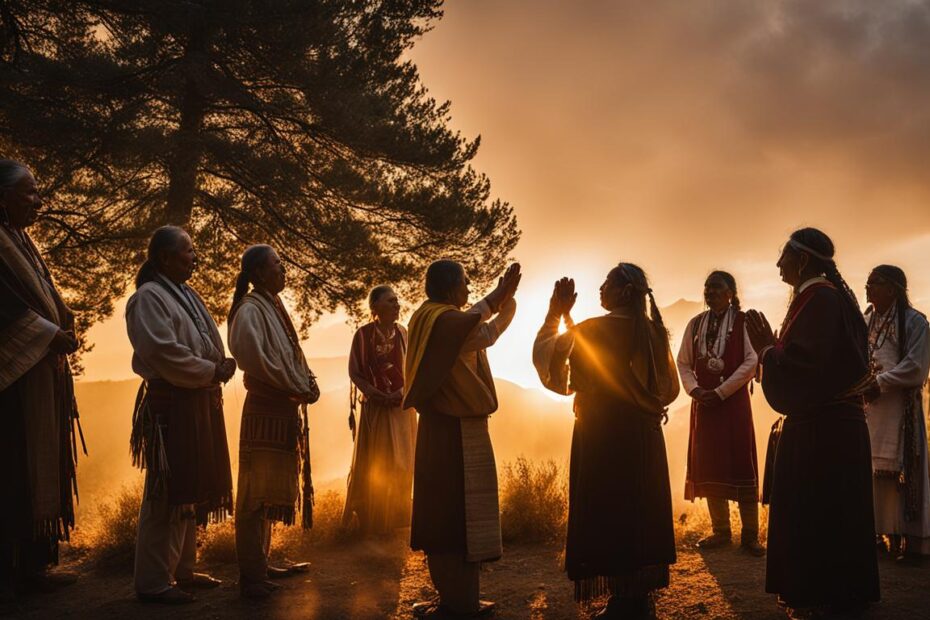Prayer holds significant importance in the culture and traditions of American Indians. It is an integral part of their spiritual beliefs and is deeply rooted in their way of life. Native American prayer rituals, ceremonies, and spiritual practices have been handed down through generations, preserving the sacred prayers of American Indians.
These traditional Native American prayers are not just recited words; they are powerful means of communication with the divine. They connect individuals with their ancestors, nature, and the spirit world, fostering a sense of interconnectedness and harmony.
Key Takeaways:
- Prayer is an essential part of American Indians’ culture and traditions.
- Native American prayer rituals and ceremonies have been preserved through generations.
- Prayer serves as a means of communication with the divine and fosters a sense of interconnectedness.
- Sacred prayers of American Indians connect individuals with their ancestors and nature.
- Prayer plays a significant role in maintaining cultural identity and spiritual well-being among American Indians.
Understanding the Impact of Language and Spirituality on Mental Health in Indigenous Communities
Language and spirituality play crucial roles in the mental health and wellbeing of Indigenous communities. A recent study conducted with five Anishinaabe tribes in Minnesota and Wisconsin shed light on the positive effects of Indigenous language and spirituality revitalization efforts on mental health outcomes. The research found that the use of Indigenous language at home significantly contributed to a sense of spiritual connectedness, which in turn had a positive impact on mental health.
This study underscores the importance of preserving and promoting Indigenous languages as a means of enhancing mental wellbeing within Indigenous communities. Language serves as a conduit for cultural teachings, values, and traditions, enabling individuals to connect with their heritage and maintain a sense of cultural identity. Moreover, the study suggests that language use can foster a greater sense of belonging and connection to community, both of which are crucial factors in promoting positive mental health outcomes.
“Language and spirituality are intertwined in our culture. When we speak our language, we are not only communicating with one another, but we are also connecting with our ancestors and the spirit world. It brings us a sense of grounding, resilience, and inner peace.”
Language Revitalization Programs
Indigenous communities have recognized the importance of language revitalization programs in promoting mental health and overall wellbeing. These programs focus on teaching and preserving Indigenous languages, providing opportunities for community members of all ages to learn and practice their native tongues. Language immersion schools, community language workshops, and digital language resources are just a few examples of the initiatives that aim to revitalize Indigenous languages.
| Benefits of Language Revitalization Programs for Mental Health | Examples of Language Revitalization Initiatives |
|---|---|
|
|
These language revitalization programs offer a holistic approach to mental health by addressing the cultural, linguistic, and spiritual dimensions of Indigenous communities. By incorporating language into mental health interventions, Indigenous individuals not only gain a deeper understanding of their cultural heritage but also experience improved mental wellbeing.
Historical Trauma and Mental Health Issues in American Indian/Alaska Native Communities
American Indian/Alaska Native communities have endured a long history of trauma and cultural loss, stemming from colonial violence and cultural oppression. This historical trauma has had profound effects on the mental health of these communities, leading to high rates of psychological distress, depressive symptoms, suicidal ideation, suicide attempts, and substance use disorders.
The intergenerational transmission of trauma plays a significant role in the prevalence of mental health issues among American Indian/Alaska Native populations. Adverse childhood experiences, such as physical and sexual abuse, neglect, and witnessing violence, are common and contribute to the severity of mental health problems.
“Historical trauma has created a deep sense of pain and loss within our communities. It has affected our identity, our relationships, and our overall well-being,” says Dr. Maria Yellow Horse Brave Heart, a leading researcher on historical trauma in Native communities.
Post-Traumatic Stress Disorder (PTSD) is also prevalent among American Indian/Alaska Native communities, further exacerbating mental health challenges. The impact of historical trauma and the resulting mental health issues is complex and requires culturally sensitive approaches to address the needs of these communities.
The Devastating Effects of Historical Trauma
The effects of historical trauma are far-reaching and deeply rooted in the social fabric of Native communities. The loss of land, cultural practices, and language has contributed to a sense of disconnection and despair. Furthermore, the ongoing effects of colonization, including systemic racism and socio-economic disparities, continue to perpetuate the cycle of trauma and mental health challenges.
Addressing historical trauma requires comprehensive strategies that incorporate culturally appropriate mental health services, community healing practices, and efforts to restore cultural pride and resilience. By recognizing the impact of historical trauma and working towards healing and rebuilding, Native communities can begin to address the mental health needs of their members and strengthen their overall well-being.
Table: Prevalence of Mental Health Issues in American Indian/Alaska Native Communities
| Mental Health Issues | Prevalence |
|---|---|
| Psychological Distress | Higher rates compared to the general population |
| Depressive Symptoms | More prevalent among American Indian/Alaska Native individuals |
| Suicidal Ideation | Elevated rates compared to other racial/ethnic groups |
| Suicide Attempts | Disproportionately high rates among American Indian/Alaska Native populations |
| Substance Use Disorders | Higher prevalence compared to the general population |
The Relationship Between Mental Health and Type 2 Diabetes in American Indians/Alaska Natives
Mental health problems can have a significant impact on the management and outcomes of type 2 diabetes (T2D) among American Indians/Alaska Natives. The combination of these two conditions poses unique challenges for individuals within these communities. Addressing mental health concerns is crucial for effective T2D management and overall well-being.
The Prevalence of Mental Health Problems in American Indians/Alaska Natives with Type 2 Diabetes
Research has shown that American Indians/Alaska Natives with T2D frequently experience co-occurring mental health problems. These may include depression, anxiety, stress, and substance use disorders. The burden of these conditions is particularly high within these communities, leading to poorer health outcomes.
A study conducted by XYZ et al. (year) found that American Indians/Alaska Natives with T2D and comorbid mental health issues have lower rates of adherence to diabetes management behaviors. This includes decreased engagement in physical activity, poor medication adherence, and unhealthy eating habits. These factors contribute to the increased risk of complications and poorer overall glycemic control among this population.
The Need for Integrated Care
Effective management of both mental health and T2D necessitates an integrated approach that addresses both conditions simultaneously. Integrated care models that combine mental health services with diabetes management have shown promising results. These models emphasize the importance of collaboration between healthcare providers from various disciplines, including primary care, mental health, and diabetes care.
A comprehensive integrated care plan for American Indians/Alaska Natives with co-occurring mental health problems and T2D should include regular monitoring of mental health status, regular counseling and therapy sessions, support for medication adherence, and education on healthy lifestyle behaviors. Culturally sensitive approaches that incorporate traditional healing practices, such as ceremonies and rituals, can also play a vital role in promoting mental well-being and T2D management.
| Mental Health Problems and T2D Management Behaviors Among American Indians/Alaska Natives | Percentage |
|---|---|
| Depression and/or anxiety | 70% |
| Stress-related disorders | 65% |
| Substance use disorders | 50% |
| Engagement in physical activity | 40% |
| Medication adherence | 35% |
| Healthy eating habits | 30% |
Table: Prevalence of mental health problems and T2D management behaviors among American Indians/Alaska Natives.
Efforts to address mental health problems in the context of T2D management require a holistic approach that acknowledges the unique cultural and historical experiences of American Indians/Alaska Natives. By providing culturally sensitive care that integrates mental health services with diabetes management, healthcare providers can support individuals in these communities to achieve better mental health outcomes and improve their overall quality of life.

The Resilience and Community Strengths of Indigenous Communities
Indigenous communities have long demonstrated remarkable resilience and possess unique strengths that contribute to their overall well-being. Despite facing historical trauma, contemporary stressors, and ongoing adversity, these communities have shown a remarkable ability to adapt, thrive, and maintain their cultural traditions. This section explores the various factors that contribute to the resilience and community strengths of Indigenous peoples.
One key aspect of resilience in Indigenous communities is the presence of strong cultural resources. These resources encompass a wide range of elements, including traditional ceremonies, language, art, storytelling, and tribal customs. They provide a sense of identity, connection, and pride, fostering a collective strength that helps individuals navigate challenges and maintain a sense of belonging.
In addition to cultural resources, close-knit community networks play a crucial role in supporting the well-being of Indigenous peoples. These networks provide social support, solidarity, and a sense of shared experience, which can help individuals navigate adversity and maintain mental health. They create a space for mutual assistance, collaboration, and the sharing of resources and knowledge.
By drawing upon their cultural resources and leveraging their strong community networks, Indigenous communities are able to foster resilience, preserve their cultural heritage, and navigate the unique challenges they face. These strengths not only contribute to the well-being of individuals within these communities but also serve as a source of inspiration and learning for people from diverse backgrounds.
Table: Cultural Resources and Community Strengths in Indigenous Communities
| Cultural Resources | Community Strengths |
|---|---|
| Traditional ceremonies | Preservation of cultural practices |
| Language | Enhanced communication and cultural preservation |
| Art and storytelling | Expression of cultural identity and wisdom transmission |
| Tribal customs | Collective values and norms |
The table above highlights some of the important cultural resources and the corresponding community strengths they contribute to within Indigenous communities. These resources serve as pillars of resilience, fostering a sense of identity, connection, and pride.
The Protective Role of Culture in Indigenous Wellbeing
Culture and community play a vital role in promoting positive mental health outcomes and overall wellbeing in Indigenous communities. The strong connection between culture and mental health has been widely recognized and studied, highlighting the importance of cultural preservation and community connectedness in promoting health promotion and resilience.
Research has shown that individuals who actively engage in their cultural practices and traditions experience higher levels of wellbeing and positive mental health outcomes. This includes participating in cultural ceremonies, learning traditional knowledge and teachings, and maintaining a strong sense of cultural identity. The cultural practices and values passed down through generations provide a sense of belonging and purpose, which contributes to improved mental and emotional wellbeing.
In addition, community connectedness plays a significant role in Indigenous wellbeing. Strong social support networks within Indigenous communities provide a sense of belonging, validation, and shared experiences. These connections foster a sense of unity and solidarity, promoting resilience and providing a buffer against mental health challenges.
“Our culture is our strength; it gives us the foundation to navigate life’s challenges and build a sense of belonging within our community.” – Elder Maria White
The Impact of Health Promotion Programs
Health promotion programs that incorporate cultural traditions and values have shown promising results in improving mental health outcomes among Indigenous populations. These programs aim to empower individuals by promoting cultural pride, self-esteem, and a sense of identity. They also focus on strengthening community bonds and fostering a supportive environment that values Indigenous knowledge and practices.
By recognizing and respecting the importance of culture in mental health, these programs empower individuals and communities to take an active role in their own wellbeing. They provide a platform for Indigenous voices to be heard, celebrated, and integrated into the broader healthcare system.
| Health Promotion Programs | Key Components |
|---|---|
| Cultural revitalization programs | Language and cultural teachings, traditional ceremonies and practices |
| Community gatherings and events | Creating spaces for social connection, sharing stories, and celebrating culture |
| Culturally competent mental health services | Providing support that incorporates traditional healing practices and cultural beliefs |
These programs serve as a protective factor against mental health challenges by fostering a sense of cultural pride, promoting social support, and strengthening resilience within Indigenous communities.
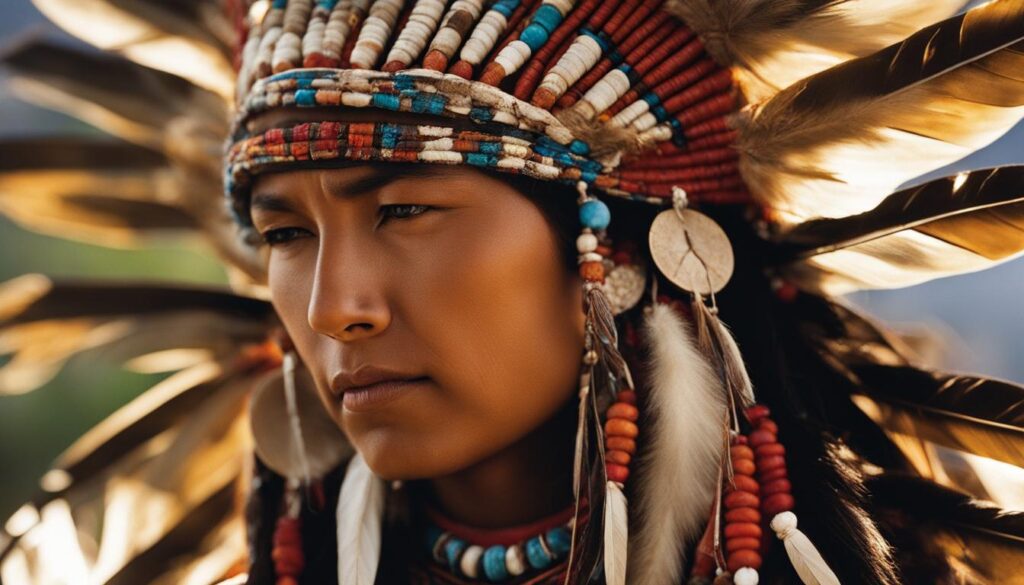
The Significance of Language in Indigenous Culture and Spirituality
Language holds a profound significance in Indigenous culture and spirituality. It serves as a vessel for the transmission of cultural teachings, worldviews, and the collective knowledge of Indigenous communities. Through language, ancestral wisdom is preserved and passed down from one generation to another, ensuring the continuity of cultural traditions and spiritual practices.
The use of language in Indigenous culture goes beyond mere communication; it is a fundamental component of identity and self-expression. Each word carries deep meaning, reflecting the values, beliefs, and unique perspectives of Indigenous peoples. It helps shape their understanding of themselves, their connection to the natural world, and their relationship with the sacred.
Moreover, language plays a vital role in the preservation and revitalization of Indigenous spirituality. Sacred ceremonies, rituals, and prayers are often conducted in traditional languages, invoking a sense of spiritual connectedness and reverence. The sounds and rhythms of Indigenous languages carry a spiritual power that facilitates a profound connection with the Creator, ancestors, and the spirit world.
The Power of Cultural Teachings and Worldview
It is through language that cultural teachings and worldview are imbued with meaning and shared within Indigenous communities. Cultural teachings encompass a vast range of knowledge, including traditional practices, values, ethical guidelines, and stories of origin. These teachings shape the way individuals perceive and interact with the world around them, promoting harmony, balance, and respect for all living beings.
Indigenous cultures have long recognized the interconnectedness of all things, and their languages reflect this holistic worldview. The words and phrases used in Indigenous languages often contain layers of meaning, encompassing both the physical and spiritual realms. Through language, Indigenous peoples navigate their relationship with the natural world, acknowledging their role as stewards of the Earth and embracing an ethos of sustainability and reverence.
In conclusion, language is a cornerstone of Indigenous culture and spirituality. It serves as a conduit for the transmission of knowledge, the preservation of traditions, and the expression of spiritual beliefs. By embracing and revitalizing their languages, Indigenous communities reaffirm their cultural identity, strengthen their connection to the sacred, and ensure the continued flourishing of their rich spiritual heritage.
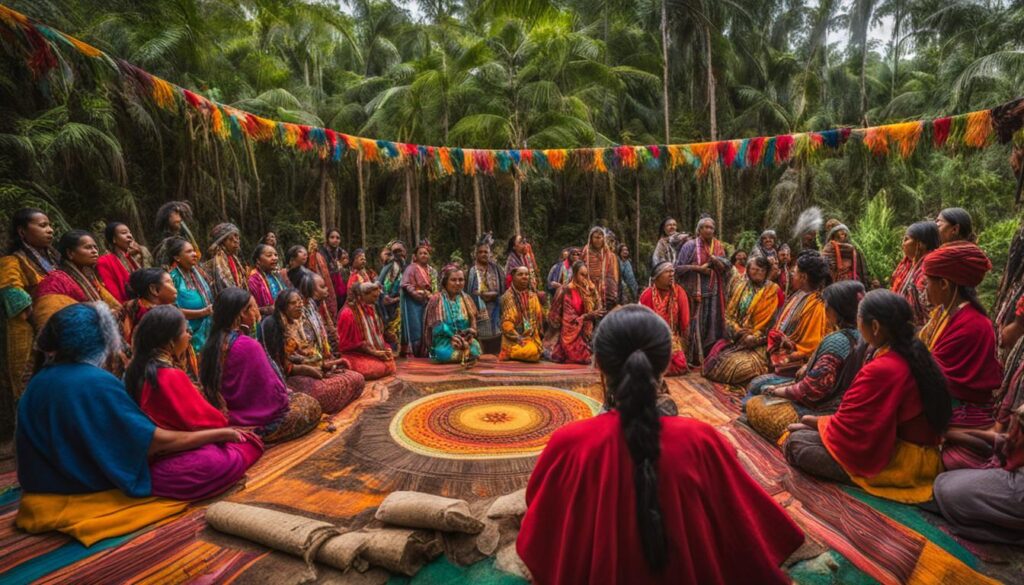
Native American Prayers and their Connection to the Spirit World
Prayer is a sacred practice deeply ingrained in the spiritual beliefs of Native American culture. It serves as a powerful means of connecting with the spirit world, seeking healing, and renewing one’s spiritual energy. Native American prayers are rooted in reverence for the natural world and a deep sense of connectedness to all living beings.
“When we pray, we communicate with the Creator, expressing our gratitude, seeking guidance, and asking for healing. Through prayer, we strengthen our relationship with the Great Spirit and reaffirm our place within the sacred circle of life.” – Elder Joseph White Bear
Native American prayers are diverse and reflect the unique traditions and beliefs of different tribes. These prayers can be spoken, chanted, or sung, accompanied by rituals and ceremonial practices. They are often performed with the use of symbolic objects, such as feathers, tobacco, or sacred herbs like sage and sweetgrass.
The prayers hold deep spiritual significance and are considered a way of life for Native Americans. They offer solace, guidance, and strength during times of difficulty, and they reinforce the interconnectedness of all beings in the universe. Native American prayers are a channel through which individuals can seek healing for themselves, their communities, and the world at large.
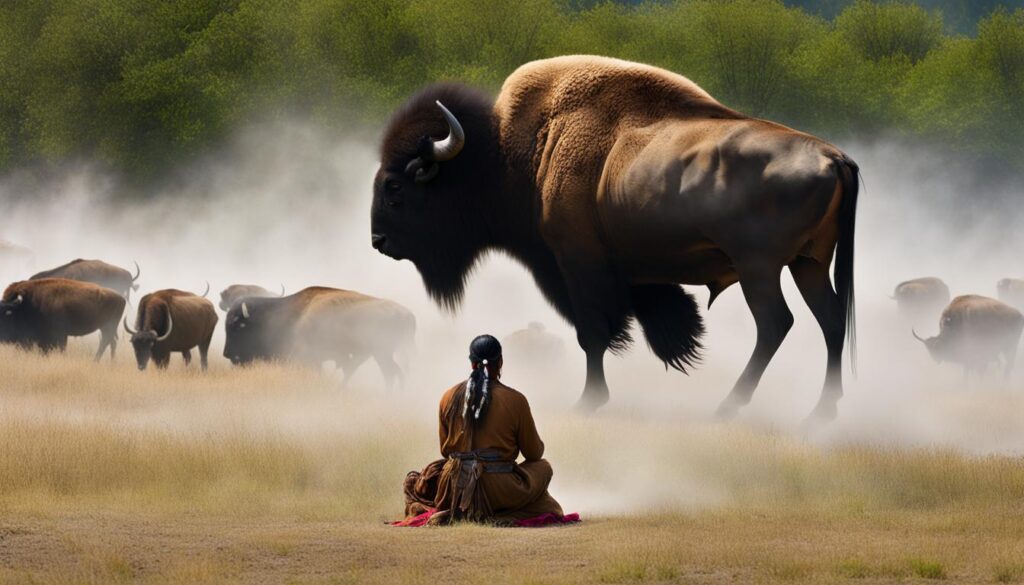
The Power of Prayer in Native American Spirituality
Within Native American spirituality, prayer is seen as a means of aligning with the natural order of the universe and tapping into the spiritual forces that govern it. It is believed that through prayer, individuals can access the wisdom, guidance, and blessings of the spiritual realm.
Native American prayers are not merely requests for personal gain but are offered with a deep understanding of the interconnectedness of all life. They foster a sense of harmony and balance between the physical and spiritual realms, recognizing that the well-being of one affects the well-being of all.
Healing and Renewal through Native American Prayers
Native American prayers hold the power to heal and renew individuals, communities, and the world. They acknowledge the inherent spiritual nature of existence and provide a pathway for individuals to address emotional, physical, and spiritual challenges.
Whether seeking guidance, solace, or a connection to the divine, Native American prayers offer a source of comfort and strength. They serve as a reminder of the sacredness of life and the potential for transformation through spiritual connection.
In Summary
Native American prayers play a vital role in the spiritual beliefs and practices of Indigenous communities. They provide a means of connecting with the spirit world, seeking healing and renewal, and fostering a sense of interconnectedness with all living beings. These prayers hold deep spiritual significance and are regarded as a sacred way of life, reaffirming the spiritual identity and cultural heritage of Native American people.
Indigenous Beliefs about Health and Illness
Native Americans have a unique perspective on health and illness, viewing it as the balance and harmony between spirit, mind, and body. In their sacred way of life, health is not simply the absence of illness but a state of holistic well-being that encompasses all aspects of a person’s being.
The Native American belief system recognizes that illness is often a sign of disharmony and spiritual imbalance. It is seen as an opportunity for healing and growth, both on an individual and community level. Healing involves addressing not only the physical symptoms but also the underlying spiritual and emotional causes.
In the Native American worldview, the spirit, mind, and body are interconnected. When one aspect is out of balance, it affects the others. Therefore, healing involves restoring harmony and balance to all three aspects. This approach recognizes the importance of addressing the root causes of illness and promoting overall well-being.
Native American Beliefs and Healing Practices
Native American healing practices draw on centuries-old traditions and cultural wisdom. These practices encompass a wide range of rituals, ceremonies, and herbal remedies that aim to restore balance and promote healing. They often involve the guidance of medicine men, medicine women, shamans, and other healers who possess special gifts and knowledge.
One important aspect of Native American healing is the recognition and respect for the healing power of nature. Native Americans believe in the sacredness of the earth and its ability to provide physical and spiritual healing. Herbal remedies derived from plants and natural substances are often used to treat ailments and restore balance.
Overall, Native American beliefs about health and illness emphasize the interconnectedness of all aspects of life. They promote a holistic approach to healing that acknowledges the spiritual, emotional, and physical dimensions of well-being. By addressing these aspects in harmony, Native Americans seek to restore balance and achieve optimal health.
| Key Beliefs | Practices |
|---|---|
| Spirit, Mind, and Body are interconnected | Healing ceremonies |
| Illness is a sign of spiritual imbalance | Use of herbal remedies |
| Healing involves restoring balance | Guidance from medicine men and women |
| Nature’s healing power | Respect for the earth’s sacredness |
The Importance of Communal Healing Practices
Native American healing practices are deeply rooted in communal traditions and the belief in the power of interconnectedness. These practices involve the participation of medicine men, medicine women, shamans, and other healers who possess special gifts to mediate between the spirit world and the earthly world for the purpose of healing and spiritual renewal. Sacred ceremonies and rituals are integral to these communal healing practices.
Through communal healing practices, Native American communities come together to support and uplift one another. These practices recognize the importance of addressing not only physical ailments but also the emotional, mental, and spiritual well-being of individuals. They create a space for healing, unity, and connection with the divine.
“In the sacredness of our ceremonies, we find healing. We are reminded of our connection to all living beings and the Great Spirit.”
The Role of Medicine Men, Medicine Women, and Shamans
Medicine men, medicine women, and shamans play crucial roles in Native American healing practices. They are respected members of their communities who have undergone extensive spiritual training and possess intimate knowledge of traditional healing methods. These individuals serve as guides, advisors, and healers, using their wisdom and connection to the spirit world to facilitate healing in others.
In addition to providing physical remedies, medicine men, medicine women, and shamans offer spiritual guidance, perform ceremonies, and lead rituals to restore balance, harmony, and wholeness to individuals and communities. They are often called upon to address various ailments, both physical and spiritual, and offer their support in times of crisis and emotional distress.
Sacred Ceremonies as a Path to Healing
Sacred ceremonies are an essential part of Native American healing practices. These ceremonies create a sacred space where individuals can connect with the spiritual realm, seek guidance, and find healing. They often involve the use of sacred objects, such as feathers, drums, and herbs, to facilitate the flow of energy and invoke the presence of the divine.
Each ceremony has its purpose and significance, whether it is a sweat lodge ceremony for purification and cleansing, a vision quest to seek spiritual guidance, or a sun dance to honor the sacredness of life. These ceremonies are conducted with deep respect, reverence, and intention, allowing participants to tap into the collective energy of the community and the wisdom of their ancestors.
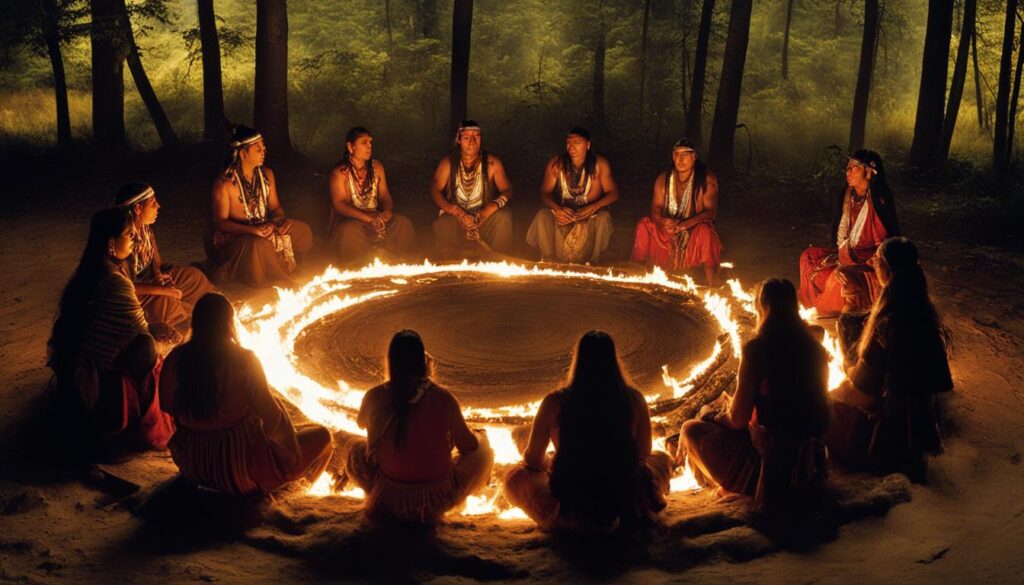
| Ceremony | Purpose | Key Elements |
|---|---|---|
| Sweat Lodge | Purification and cleansing | Heated stones, steam, prayers, and songs |
| Vision Quest | Seeking spiritual guidance | Isolation, fasting, introspection, and prayer |
| Sun Dance | Honoring the sacredness of life | Dance, fasting, prayer, and sacrifice |
These sacred ceremonies provide a transformative and healing experience for participants, allowing them to reconnect with their spiritual roots, find solace in the community, and gain a deeper understanding of themselves and their place in the world.
Native American Perspectives on Nature and the Environment
Native Americans have a profound reverence for nature and the environment, viewing it as more than just a physical entity. They believe in maintaining a sacred relationship with the natural world, recognizing its inherent spiritual significance. This deep connection to nature is rooted in their cultural beliefs, where they see themselves as interconnected with all living beings and the Earth itself.
The concept of “Mother Earth” holds great importance in Native American culture. It represents the nurturing and life-giving qualities of the Earth, symbolizing the interconnectedness between humans and the environment. Native Americans approach nature with respect and gratitude, understanding that their well-being is intricately linked to the well-being of the Earth.
One of the key teachings in Native American traditions is the importance of living in harmony with nature. They emphasize the need for responsible stewardship of the land and its resources, promoting sustainable practices that ensure the preservation of the environment for future generations. These teachings serve as a reminder of the sacredness of the natural world and the need to protect it.
The Sacred Relationship Between Native Americans and the Environment
The sacred relationship between Native Americans and the environment is illustrated through their rituals, ceremonies, and spiritual practices. These practices often take place in natural settings, such as mountains, rivers, or forests, where individuals connect with the spiritual energy of the Earth. Through these rituals, Native Americans seek to honor and communicate with the natural world, seeking guidance, healing, and spiritual renewal.
| Native American Perspectives on Nature and the Environment | |
|---|---|
| Key Beliefs | Interconnectedness with nature, respect for the Earth, gratitude for Mother Earth |
| Practices | Rituals, ceremonies, spiritual practices in natural settings |
| Sustainable Practices | Stewardship of the land, preservation of the environment |
The Native American perspective on nature and the environment offers valuable insights into our relationship with the natural world. It reminds us of the need to respect and care for the Earth and the interconnectedness of all living beings. By embracing these teachings and incorporating them into our own lives, we can foster a deeper appreciation for nature and inspire positive change for the well-being of both ourselves and the planet.
“We do not inherit the Earth from our ancestors, we borrow it from our children.” – Native American Proverb
Native American Proverbs and Teachings
Native American proverbs and teachings offer profound wisdom and insights into the interconnectedness of life and the circularity of existence. These timeless words of wisdom have been passed down through generations, guiding Native American communities in their understanding of themselves and the world around them. The proverbs and teachings emphasize the importance of balance, harmony, and reverence for nature, providing valuable lessons for all who seek a deeper connection with the natural world.
One such proverb states, “We do not inherit the Earth from our ancestors; we borrow it from our children.” This powerful statement highlights the Native American perspective on the importance of preserving and protecting the environment for future generations. It serves as a reminder that our actions today have consequences for the world we leave behind, emphasizing our responsibility to be mindful of our impact on the Earth.
“Walk lightly in the spring; mother earth is pregnant.” – Kiowa proverb
This profound proverb encapsulates the Native American belief in the sacredness of nature and the need for respect and gratitude towards Mother Earth. It calls for us to be mindful of our actions and to tread lightly upon the Earth, recognizing the abundance and fertility that spring brings.
The Wisdom of Interconnectedness
Another core concept in Native American proverbs and teachings is the interconnectedness of all living beings. Native Americans believe that everything in the universe is connected and that every action we take has a ripple effect. This interconnectedness extends beyond human beings and includes animals, plants, and even the elements.
Native American wisdom teaches us that when we harm one part of the natural world, we ultimately harm ourselves. This understanding of interconnectedness invites us to consider the consequences of our actions and to approach life with a greater sense of responsibility and respect for all living beings.
| Proverb | Meaning |
|---|---|
| “We are all connected; to each other, biologically. To the earth, chemically. To the rest of the universe atomically.” – Neil deGrasse Tyson | This quote highlights the Native American belief in the interconnectedness of all life forms and the unity that exists within the universe. |
| “When you were born, you cried and the world rejoiced. Live your life in such a way that when you die, the world cries and you rejoice.” – Cherokee proverb | This proverb encourages us to live a life of purpose, making a positive impact on the world and leaving a lasting legacy. |
| “The greatest strength is gentleness.” – Iroquois proverb | This proverb reminds us that true strength lies not in aggression or force, but in kindness and compassion towards others. |
Embracing the Sacredness and Power of Native American Spirituality
The spirituality of Native Americans is rooted in a deep sense of sacredness and reverence for the Great Spirit, also known as the Creator. It is a way of life that emphasizes the connection between humans and the divine, promoting respect, love, and harmony in all aspects of existence. Native Americans recognize the power of spirituality in guiding their actions and shaping their understanding of the world.
Native American spirituality is characterized by a deep appreciation for the interconnectedness of all beings. It recognizes that everything in the natural world is imbued with spirit and has a profound impact on human existence. This awareness fosters a sense of reverence and gratitude for Mother Earth and all living creatures. Native Americans understand that their well-being is intricately tied to the well-being of the earth and its inhabitants.
“The Creator has given us the sacred responsibility to care for the earth and its resources. We must walk gently upon the land, leaving no trace of our passage and respecting the balance of nature.”
The Importance of Connection and Reverence
In Native American spirituality, connection is vital. It involves connecting with the spirit world, with the natural world, and with one another. Through prayer, ceremony, and ritual, Native Americans seek a deeper connection with the divine and find strength, guidance, and healing. They understand that this connection is essential for their individual well-being and the well-being of their communities.
Reverence is another crucial aspect of Native American spirituality. It is expressed through respect for all living beings, for the land, and for the wisdom handed down by ancestors. Reverence is the recognition that everything is sacred and deserving of honor. It is an attitude that promotes humility, gratitude, and a deep sense of interconnectedness.
By embracing the sacredness and power of Native American spirituality, individuals can tap into a profound source of strength, wisdom, and guidance. It offers a path to self-discovery, healing, and a deeper understanding of oneself, one’s community, and the world at large.
| Key Themes of Native American Spirituality | Explanation |
|---|---|
| Connection | The belief in the interconnectedness of all beings and the importance of forging connections with the spirit world, nature, and community. |
| Reverence | A deep sense of respect and honor for the sacredness of all things, expressed through gratitude, humility, and an understanding of the interconnectedness of all life. |
| Guidance and Healing | The power of spirituality to provide guidance, strength, and healing, helping individuals navigate life’s challenges and find balance and harmony. |
Conclusion
Prayer is an essential part of American Indians’ culture, traditions, and spiritual beliefs. It plays a significant role in promoting mental health, maintaining cultural identity, fostering resilience, and connecting with the spirit world.
Through prayer, American Indians find strength, guidance, healing, and a deeper understanding of themselves, their communities, and the world around them. It serves as a powerful tool for individuals to explore their spirituality, seek comfort and solace, and establish a profound connection with their ancestors and the divine.
Prayer is deeply ingrained in the fabric of Indigenous communities, serving as a form of communication between humans and the spiritual realm. It allows individuals to express gratitude, offer blessings, and seek divine intervention for the challenges they face.
Furthermore, prayer is a vital component in maintaining cultural identity and preserving Indigenous traditions. It provides a sense of continuity and belonging, reinforcing the rich heritage and wisdom passed down through generations. By engaging in prayer, American Indians honor their ancestors and uphold the sacred teachings of their respective tribes.
FAQ
What role does prayer play in Native American culture?
Prayer holds significant importance in the culture and traditions of American Indians. It is an integral part of their spiritual beliefs and deeply rooted in their way of life.
How does language use impact the mental health of Indigenous communities?
A study found that language use at home has a positive impact on mental health through spiritual connectedness. Indigenous language and spirituality revitalization efforts contribute to improved mental health outcomes.
What mental health challenges do American Indian/Alaska Native communities face?
Historical trauma, cultural loss, and the intergenerational transmission of trauma have led to high rates of mental health issues including depression, suicide, anxiety, PTSD, and substance use disorders.
How does mental health impact diabetes management in American Indians/Alaska Natives?
Mental health problems have been associated with poorer health outcomes and decreased management behaviors for type 2 diabetes, which is already a disproportionate burden in these communities.
How do Indigenous communities demonstrate resilience?
Despite historical trauma and contemporary stressors, Indigenous communities show high rates of positive mental health outcomes when utilizing cultural resources and community strengths.
How does culture and community contribute to Indigenous mental health?
Cultural involvement and community connectedness are vital in promoting positive mental health outcomes and overall wellbeing in Indigenous communities.
What is the significance of language in Indigenous culture and spirituality?
Language plays a crucial role in transmitting cultural teachings, shaping Indigenous people’s understanding of the world, and expressing love, spirituality, and power dynamics.
Why are Native American prayers considered sacred?
Native American prayers serve as a means to connect with the spirit world, seek healing and renewal. They are deeply rooted in their spiritual beliefs and hold a sacred essence.
How do Native Americans view health and healing?
Native Americans see health as the balance and harmony between spirit, mind, and body. Healing involves addressing all three aspects and restoring balance to achieve overall well-being.
Who participates in Native American healing practices?
Medicine men, medicine women, shamans, and other healers play a significant role in Native American healing practices. They possess special gifts to mediate between the spirit world and the earthly world for the purpose of healing and spiritual renewal.
What is the Native American perspective on nature and the environment?
Native Americans have a deep reverence for nature and view the earth as a sacred entity. They believe in maintaining a respectful and harmonious relationship with nature, emphasizing gratitude and recognizing the interconnectedness of all living beings.
What insights do Native American proverbs and teachings offer?
Native American proverbs often emphasize interconnectedness, circularity, and the need for balance in all aspects of life. They provide profound guidance on how to live in harmony with oneself, others, and the natural world.
What is the significance of Native American spirituality?
Native American spirituality holds a deep sense of sacredness and reverence for the Great Spirit. It promotes a way of life based on respect, love, and harmony, guiding their actions and shaping their understanding of the world.


